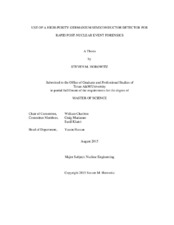| dc.description.abstract | This thesis investigates the ability of a high-purity germanium detector to perform post-detonation forensics on the debris from several types of nuclear weapons 24 hours after detonation. The ultimate result of this analysis would be the deployment of this detector on an autonomous robot for sample collection and remote analysis. Monte Carlo N-Particle Transport Code Version 6 (MCNP6) was utilized to simulate the detonation of five nuclear weapon loadings to a yield of 10 kilotons of TNT. Simulations included uranium weapons of 20%, 50%, and 90% enrichment, as well as reactor-grade and weapons-grade plutonium weapons. The resulting isotopics were assumed to be distributed evenly as fallout, and this fallout composition was utilized to generate a source term through the use of photon yield databases. A high-purity germanium detector was modeled in MCNP6. Using this model and the source term, the predicted response spectrum for each fallout composition was generated and compared using Genie spectroscopy software in an attempt to find differentiating features between them.
The ability to distinguish between fallout originating from a uranium or plutonium weapon was identified. If the ratio of photopeak count rates at 320 keV and 251 keV is near to or less than 0.05, the initial weapon loading was likely uranium. Once identified to be uranium, the count rate ratio of the 108 keV to the 251 keV photopeak can be utilized to determine a range for the initial uranium enrichment. The relative height of the 108 keV peak due to 239Np changes drastically based on initial enrichment due to differences in the production of 239Np from neutron capture in 238U and subsequent beta decay.
If the ratio of photopeak count rates at 320 keV and 251 keV is greater than 0.06, the initial weapon was likely plutonium. A methodology to distinguish between weapons-grade and reactor-grade plutonium was not identified. This is due to the similar fission yields of the plutonium isotopes, while yields of uranium and plutonium isotopes are sufficiently-different to allow for variations in the fallout spectra. | en |


